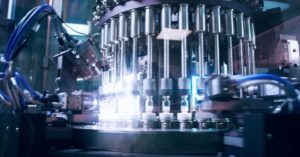
7 Trends in Robotic Automation Relevant to the Medical Device Industry
Robotics technologies have been in use in medical device manufacturing facilities for a number of decades now. However, the pace of development in this field of technology has increased significantly over recent years creating new possibilities and opportunities.
We see this on almost every project we work on at ATS. We specialise in designing and building machines for medical device manufacturing facilities. Robots are crucial components of the machines we build.
Here are seven of the most important robotic automation trends that are relevant to the medical device manufacturing industry.
1. The Use of Artificial Intelligence
Artificial intelligence (AI) is increasingly being used in medical device manufacturing facilities to make processes more efficient. In particular, a specific branch of AI – machine learning.
This is the ability of a robot to assess, analyse, and then make adjustments in real-time, improving the efficiency and productivity of the task it is performing.
This ability will become even more important with the growing popularity of mass customisation where robots will be involved in manufacturing mass produced medical devices in batch sizes of one.
2. A Focus on Cybersecurity
Cybersecurity is currently – and will remain – a central priority as more and more robotics technologies are introduced to medical device manufacturing facilities.
Sensor technologies, data analysis, controls systems, and more mean these robotics technologies don’t exist in isolation. Instead, they are interconnected with other platforms, machines, and equipment not just on the factory floor, but in the wider business and supply chain.
With this exposure to the internet comes cybersecurity risks. Therefore, it’s essential that technologies, systems, training, and more keep pace with the speed of technological development in robotics.
3. Data Analysis
Data is already important to the profitability of medical device manufacturing businesses – that importance is only going to increase in the years and decades to come.
With the right data, you can do everything from optimising OEE to developing better products to improving customer service.
Crucially, however, the main task is not the collection of data. With technologies like sensors, always connected devices, and cloud computing, data collection is relatively easy.
It’s what you do with the data you collect that is most important.
In other words, organising, analysing, and making sense of data is crucial to success.
4. Virtual Solutions
We are also currently seeing the increasing use of virtual solutions in robotics. Examples include:
- Engineers using mixed reality technologies to provide real-time support to manufacturing facilities, regardless of location
- The use of digital twins for predictive maintenance and machine performance modelling
- Creating robotic systems in a virtual environment for applications such as proof of concept, software development, and more
5. Collaborative Robots
The increasing use of collaborative robots, or cobots, is one of the most visible technological advances in robotics. Collaborative robots are robots that can safely work alongside people.
One of the most exciting applications in this field is the development of mobile collaborative robots. These machines are usually lightweight and compact and are able move around the factory floor.
The use of collaborative robots like this is another step towards automating the entire production process, from raw material delivery to shipping the completed packaged product.
6. Improved Dexterity of Robotic Arms
Significant advances are being made in the dexterity of robotic arms, making them more adaptable and suitable to a wider range of manufacturing environments. This includes medical device manufacturing which often involves small and delicate components.
7. Robots Built with a Modular Design
Robot manufacturers are increasingly developing machines built with a modular design.
One of the main benefits of this approach is that it means a single robot can perform multiple tasks simply by swapping parts such as grippers and joints. This can, for example, make strategies like mixed manufacturing and mass customisation more feasible.
The Industry 4.0 Umbrella
All of the technologies and trends described above come under the Industry 4.0 umbrella. This demonstrates the importance of robotics to the development of the smart factory.
ATS is a member of the Atlantic MedTech Cluster. Please visit the ATS website to find out more about its services capabilities.
